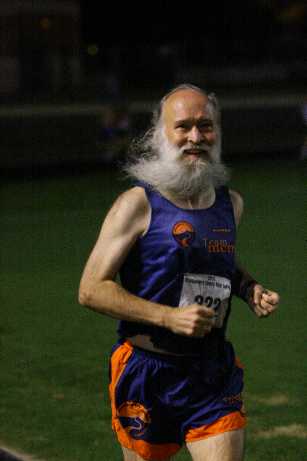
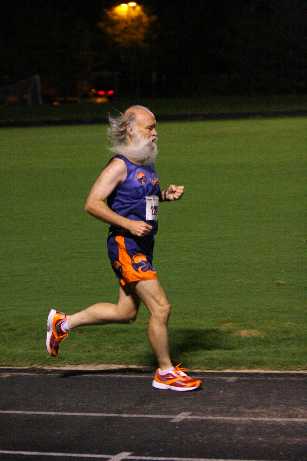

Howdy, pilgrim! No ads — you're in volume 0.85 of the ^zhurnal (that's Russian for "journal") — see ZhurnalyWiki for a Wiki edition of individual items; see Zhurnal and Zhurnaly for quick clues as to what this is all about; see Random for a random page. Briefly, this is the diary of ^z = Mark Zimmermann ... previous volume = 0.84 ... complete list at bottom of page ... send comments & suggestions to "z (at) his (dot) com" ... click on a title link to go to that item in the ZhurnalyWiki where you can edit or comment on it ... RSS
"Your compass spins wildly!" In one of the earliest text-adventure games that I played on a primitive computer many decades ago I remember a room in which one couldn't tell direction. The same thing happens to me on Sunday 29 August, perhaps coincidentally 24 hours after an all-night trail run. Fortunately I recognize the symptoms: I had it briefly three years ago, on 2007-03-10. Then and now, when I roll over in bed I suddenly feel dizzy. The room rotates around me for several seconds, then settles down. When I change the orientation of my head again, it happens again. I recognize it, and a few days later my helpful and supportive doctor (Deena Shapiro) confirms the self-diagnosis.
It's Benign Paroxysmal Positional Vertigo a.k.a. BPPV, and is caused by out-of-place calcium crystals in the inner ear, called otoconia or otoliths ("ear rocks"). They move around when the head turns, disturb the fluid in the motion-sensing semicircular canals, and cause a feeling that the head is turning when it's not. The eyes twitch (nystagmus) and the head swims. My BPPV hasn't gone away for a fortnight and thus far isn't too much of a problem. It strikes when I try to look straight up at the stars, when I lie down or sit up abruptly, and when I tip my head sideways to read the titles of books on the shelf. After a few seconds the merry-go-round stops. We'll see how long it persists; the doctor recommends living with it if it doesn't get any worse. So far, so good: it's a cheap thrill, provides considerable amusement to colleagues when I demonstrate it, and doesn't seem to interfere with my running or other activities. And I haven't fallen down yet!
(cf. 2010-08-27 - Cheat Mountain Moonshine Madness and notes on the 10 March 2007 run AggressiveResting (2007-03-17), ...)
- Sunday, September 12, 2010 at 03:27:02 (EDT)
At about 4:00am, on a muddy trail in a West Virginia forest, Carolyn Gernand runs past me. "I don't think we're going to make the next cutoff," I say, sadly.
"Shut up!" is Carolyn's instant reply. She stays positive. The glow of her flashlight soon vanishes and I'm left alone in the woods at night.
Madness is the watchword for an all-night run over the mountains of West Virginia. The drive to the 4-H camp near Beverly WV is ~200 miles each way, and since comrade Kate is recovering from injury I make it solo, leaving work early on Friday afternoon and arriving a couple of hours before sundown. The highway system is a patchwork of freeways segments named after Senator Robert Byrd that abruptly end in narrow country roads. Small towns provide traffic jams. I see only one Confederate flag but plenty of phalanxes of motorcycles, cute churches, forested hills, and rocky ridges.
To avoid intestinal distress during the evening odyssey I eat cautiously during the day. At the Front Royal exit from I-66 I pause to get gas and also purchase a half-pound bag of crunchy Cheetos and a liter of Dr. Pepper. They're my dinner: I nibble and sip along the way. The salty greasy low-fiber high-caffeine diet is the perfect fuel.
The "Cheat Mountain Moonshine Madness" 50 miler for me is a training run, to see how it feels to run through the night. It's an extension of the five hour experiment (cf. 2010-08-14 - Night Run - Karen's Loop) that Karen Taber and I did a fortnight ago. I arrive and park the MINI Cooper in a grassy meadow with the other runners' vehicles. Next to me is Tim Gavin, race director of the HAT Run. We chat and discuss future events. At check-in I find Karen and meet her husband Darryl. They arrive early on Friday and set up a tent at the nearby camping area, where Karen naps a bit. Comrade Carolyn Gernand arrives later, and I make introductions. At 9pm we set off, Karen and Carolyn with me at the back of the pack.
The CMMM course is two-thirds country road, mostly packed dirt, and one-third single-track trail. The roads for the first half of the event climb, often steeply, from the valley to the ridge line that forms Cheat Mountain. I manage to make ~14 min/mi for the first dozen miles and leave Carolyn and Karen behind.
But then comes the first trail segment, and that's when I discover what will prove my downfall: the ground is uneven, a narrow rutted path between ferns, frequently interrupted by roots and muddy bogs. I don't dare run, lest I fall, and so am reduced to speed-hiking. I make occasional pauses to locate blazes (blue metal diamonds) and course markers (retroreflective strips dangling from ribbons tied to branches). My pace is 20-25 min/mi—far too slow!
Half a mile into the woods after Aid Station #2, suddenly I hear a noise behind me. It's Karen! She is amazingly fast on the trail, and after a brief chat runs ahead out of sight. I continue to trek along, slip-sliding in the muck and washing my shoes off during shallow stream crossings. How can there be so much water at the top of a mountain after several days without rain?
After ~4 miles the trail emerges onto road and I can run again. Aid station volunteers are friendly and helpful. After a mile I'm back in the woods and have to revert to a crawl. Carolyn catches up and passes me. The first official cutoff, AS #4 = mile 23.2, is 6.5 hours = 3:30am. I make it with ~5 minutes to spare; Karen and Carolyn are there shortly ahead of me, just leaving as I arrive. I hasten through and pass them on the road, but in the next forest segment Karen sails by me, followed soon by Carolyn.
Continuing by myself I slip several times, bang my left shin on a log, and at mile ~29, fall on my back. A step on a wet mossy rock betrays me and my other foot lands in a hole during the recovery attempt. Fortunately there's no major damage, just a couple of small scrapes. But alas, my cutoff prediction proves right: at AS#6 = mile 33.3 Carolyn is ~10 minutes late, and I'm another ~10 minutes behind her. Karen, however, makes it here with a couple of minutes to spare—yay! Her husband Darryl gives me the good news and offers me a ride back to the start. We pick up Carolyn who is hiking along the road, and arrive back at the 4-H campground about 8am.
I feel alert and foolishly decide to drink some coffee but skip the 10am breakfast/award ceremony. During the trip home I get sleepy every hour and pull off the highway to take a 10-15 minute nap. I arrive safely by early afternoon. Later I learn the Really Good News: Karen Taber runs the last ~17 miles and makes the final 13 hour finish-line cutoff with 2.5 minutes to spare. Hooray!
Bottom line: the experiment in running all night goes well. I feel fine mentally, though my peripheral vision keeps glimpsing cabins, mailboxes, etc. in the woods where there's nothing. No drama—that's good.
- Friday, September 10, 2010 at 05:00:52 (EDT)
Unlike angst-ridden theoreticians, most experimental physicists are jovial, practical, straightforward people. They have to be, in order to do jobs which involve working with others on huge collaborative teams and overcoming problems with delicate, complex equipment. Burton Richter is an experimenter. He got his Nobel Prize many years ago, he's 79, and he can say whatever he wants to. In Beyond Smoke and Mirrors he explores the tangled issues surrounding global warming and potential responses to it. The critical thinking and rigorous in-depth analysis that be brings to the subject are presented in remarkably fast-reading, chatty, yet thoughtful prose.
As Richter summarizes the situation in the Introduction, "... unfortunately, there are more senseless arguments than sensible ones, and still more that are self-serving." He dismisses both the deniers and the exaggerators of global climate change, and comes down squarely in between on the side of reason. Part I of the book "explains what we know, what we don't know, and how urgent is the need for action." Part II discusses energy, technology, and economics; Part III focuses on politics. Richter provides excellent historical context, going back to an 1896 climate model of the Swedish chemist Arrhenius which predicted about the same amount of warming from CO2 that the current sophisticated models give.
To jump ahead to the "answers" that Burt Richter identifies: the big winners are efficiency, coal with carbon capture/storage, hydroelectricity, geothermal systems, nuclear power, natural gas, and several less immediate areas for investment. The losers (bad strategies) are coal without carbon capture/storage, petroleum or hydrogen used to power transportation, and corn ethanol. Politics intervenes in many of these and promotes irrational, inefficient behavior. As the author notes at the end of Chapter 17, "Since I have become involved in energy and proliferation issues I have learned one new thing: politics—particularly international politics—is much harder than physics."
Chapter 18 nicely summarizes the take-away messages:
- Thursday, September 09, 2010 at 04:38:42 (EDT)
For once, I beat Caren Jew to a run! I miscalculate the distance to Black Rock Mill and arrive 20 minutes early; Caren is only 7 minutes ahead of our planned 6am start. But heavy clouds make it a dark dawn, so instead of scrambling up the steep hillside we walk briskly up Black Rock Rd and, by the time we reach the top, it's light enough to join the trail at the Button Farm entrance gate. We follow the usual big white-yellow-orange loop, clearing overnight spiderwebs with our faces until a couple of mountain bikers pass us and begin to take on that task. A rooster crows in the distance.
Light showers drift through, and though temperatures are in the low-to-mid 70s humidity is high and I'm soon sweat-soaked. Intermittent breezes help. The corn is high, the soybeans are thick, and when I step off the trail for a moment to contemplate nature I have to avoid poison ivy. Big roll-bales of hay are oddly in the woods by the path, perhaps having tumbled downslope from the fields above? A deer near the cellphone tower flees as we approach. Caren glimpses a large noisy bird, and points out the bicycle in the tree that marks where the side trail branches back down to our starting point. But today we continue along—running up a hill after a fast youngster races past us—to exit where we entered and add a mile to the day.
(cf. 2009-05-31 - Schaeffer Farms, 2010-07-03 - Schaeffer Farms, ...)
- Wednesday, September 08, 2010 at 04:47:32 (EDT)
If, as per Genesis 2:24 etc, a married couple is "one person", then are intimate marital relations, uh, ...?!?
- Tuesday, September 07, 2010 at 04:41:17 (EDT)
Free ice cream and freee beer—who could say no to that?! So in spite of running a few dozen miles this morning, and in spite of the warm, humid, Code Orange Forecast air quality, in late afternoon I pick up Barry Smith at his home (so he can drink the free beer) and proceed to the Bachman farm in northern Montgomery County for the MCRRC Comus 5k cross-country race. I push hard and manage to finish in 26:53, 44th place overall, 5th out of 12 in my age/sex group. The ice cream cookie-sandwich I snag is superb.
- Monday, September 06, 2010 at 05:47:16 (EDT)
It took me years to learn that my teachers weren't infinitely wise and knowledgeable. Likewise, I've only gradually figured out that my bosses don't always make perfect (or even sensible) plans. Recently, another epiphany:
| Just because you read it in a book doesn't make it true! |
Sure, I always knew that errors sometimes crept into printed material, and of course I never entirely trusted opinion essays, cheap self-published pamphlets, or random web pages, But professional-looking tomes always had a gravitas for me, whatever the subject. Now, I'm beginning to suspect that their authors (and editors, and publishers) are human too ...
(cf. MuddlingThrough (2002-08-21), LookingUpGullible (2005-02-27), ...)
- Sunday, September 05, 2010 at 04:17:46 (EDT)
In the gloom at 0545 I suddenly see the big stag, with magnificent rack of antlers, eying me from a few feet away at the fork in the Capital Crescent Trail near Grubb Rd. "Hi big guy!" I tell him as I trot past, hoping not to antagonize him into knocking me down. A few miles later the rabbit hopping across the path is far less scary. I'm trekking to downtown Bethesda, as seems to have become usual, early on a Saturday morning to join Rebecca Rosenberg's "Bethesda Rebel Runners" crew for a long pleasant ramble along Rock Creek and back. The Rebels are spin-off descendant of a Jeff Galloway marathon training group many years ago.
Megan Barker, a relatively new member of the posse, is cheerfully preparing for her first marathon: San Francisco, later this year. This is her second 20 mile run so Rebecca and I give her our free advice, which consists of comments on various things plus the repeated admonition to Start Slowly and not get carried away during the first half of the race. Far easier said than done, of course! Today on a warm, humid, Code Orange air quality day we set out too fast and by mile 15 Megan is exhausted. Everyone other than the three of us has branched off at or before the National Zoo: Tom from New Zealand, sports physician and 2:48 marathoner visiting from the UK; Tom's friend Stephanie; Megan #1; comrade Barry Smith; and a new fellow who falls in with us, Nick of Bethesda, former hash harrier getting back into shape years after his single marathon.
Onward we go, slowing down and mostly walking on the CCT as Megan negotiates a peace treaty with The Wall. Like eager puppies, Rebecca and I take turns running ahead and then back to give our legs some bonus training. We catch up with MCRRC's Sharlene Deskins who's likewise walking and join her in the trek. Finally in Bethesda where we started we wish Megan and Sharlene well. (They recover quickly, I later learn.) Rebecca offers me a ride home. I gratefully accept, and salute her "Leave No One Behind" spirit. She swears me to secrecy concerning the condition of her car's interior. I can say no more.
- Saturday, September 04, 2010 at 04:38:27 (EDT)
Sunbeams sparkle down through the misty air as I follow the loop through the urban forest near work, the morning after heavy rains. During the first lap I pause half a dozen times to move fallen branches and limbs off the path, so I don't trip over them in subsequent circuits. On the second go-around I kick twigs out of the way. The third time I'm cruising, and the final loop is as fast as I can plausibly go. Pace for the marked mile: 10.2 + 9.2 + 8.4 + 7.3 min/mi.
- Saturday, September 04, 2010 at 04:29:57 (EDT)
In the Harvard Business Review (July 2010 issue) Clayton M. Christensen has an essay titled "How Will You Measure Your Life?" It's an address given to the graduating class of business school students. Among the virtues that Christensen mentions is humility:
It's crucial to take a sense of humility into the world. By the time you make it to a top graduate school, almost all your learning has come from people who are smarter and more experienced than you: parents, teachers, bosses. But once you've finished at Harvard Business School or any other top academic institution, the vast majority of people you'll interact with on a day-to-day basis may not be smarter than you. And if your attitude is that only smarter people have something to teach you, your learning opportunities will be very limited. But if you have a humble eagerness to learn something from everybody, your learning opportunities will be unlimited. Generally, you can be humble only if you feel really good about yourself—and you want to help those around you feel really good about themselves, too. When we see people acting in an abusive, arrogant, or demeaning manner toward others, their behavior almost always is a symptom of their lack of self-esteem. They need to put someone else down to feel good about themselves.
(cf. BluffingVersusHumility (1999-04-22), ...)
- Friday, September 03, 2010 at 04:43:05 (EDT)
Torrential rains leave me with one pair of soggy socks when I arrive at work, so I decide to skip the morning run opportunity and not get the other pair wet. By afternoon it's still cool, the showers have stopped, and the damp socks that I hung over my computer have dried. So out I go, humid though it is, for three ~1.5 mile circuits around the parking lot perimeter, rough pace 9.7 + 8.7 + 8.1 min/mi.
- Thursday, September 02, 2010 at 04:49:47 (EDT)
| Breathing as I run: One two three four One two three One two One |
Morning brings the urge to run, so four laps on the paved forest path go by with easy/medium/hard/quite-hard marked mile times of 10.2 + 8.8 + 7.9 + 7.2 minutes respectively. One squirrel watches my progress.
- Thursday, September 02, 2010 at 04:42:57 (EDT)
The Thinker's Guide to Scientific Thinking by Richard Paul and Linda Elder is an interesting but flawed little booklet that combines elements of the Good, the Bad, and the Ugly.
Parts of the discussion are focused and to the point:
Many sections are disorganized, misleading, or wrong:
As William Thompson (Lord Kelvin) famously said:
When you can measure what you are speaking about, and express it in numbers, you know something about it; but when you cannot measure it, when you cannot express it in numbers, your knowledge is of a meager and unsatisfactory kind: it may be the beginning of knowledge, but you have scarcely, in your thoughts, advanced to the state of science."
Many areas could be improved:
(cf. BadArithmetic (2004-02-24), ...)
- Wednesday, September 01, 2010 at 04:38:24 (EDT)
Near the National Zoo a scruffy-looking possum startles us as it scampers across the trail in front of us. I lend Karen one of my flashlights when hers goes dark. At midnight two medium-large deer dart by. It's a Saturday night training run. Karen Taber and I first meet at the 2009-01-25 - Eagle Run and more recently chat at some VHTRC training events. Karen arrives at my home at sundown and drives us to the Ray's Meadow Park on Rock Creek Trail near East-West Hwy. At 9:07pm we set out. Almost immediately an impolite cyclist cruising without lights almost hits Karen. Whoops! We proceed downstream, tiptoeing across muddy patches from flooding earlier this week.
At the Thompson Boat Center I refill my hydration backpack from the garden hose. It's 11:30pm and a crowd of people—mostly young, mostly drinking—fills the boardwalk where boats take people out on the Potomac River. Proceeding up the Capital Crescent Trail we chat about family and running, work and studies. At Fletchers Boathouse construction/destruction is underway: the latrine is gone but there's a long line of portajohns. My right knee feels weak and twinges; Karen's feet are troubled by running so far on the asphalt pavement. For variety we follow the gravel C&O Canal Towpath for a mile, then scramble up the hillside to rejoin the CCT at the Arizona Av Trestle.
At 1am in downtown Bethesda three young men are ambling along the path toward River Rd. Our pace slows in the later miles as we take increasingly long walk breaks. My tummy troubles me somewhat; I take a Succeed! e-cap every hour, eat a Snickers bar, and suck on hard candies. Before setting out I had a slice of peach pie with whipped cream on top of some ramen and salty tea/lemonade plus coffee. Karen does well nibbling on Clif Bars.
At 0145 we take a slight short-cut in the final half mile, on the CCT Georgetown Branch trail after the Rock Creek Trestle, where we climb over a broken-down fence and cross an apartment parking lot to save our tired feet a fraction of a mile. A bit before 2am we're back at Karen's truck. My shorts are soaked with sweat; she's dry. That Sunday afternoon I visit Mary Ewell and walk a few miles with her along the W&OD Trail before picking up BBQ for the family.
- Tuesday, August 31, 2010 at 04:51:04 (EDT)
The 1985 movie Remo Williams: The Adventure Begins is silly fun, an action-packed romp with a surprising density of clever lines. The other day I was mock-complaining about my age. Colleague Caryn aptly snapped back with a quote from Remo's teacher, martial-arts master Chiun. When asked if he's old, Chiun replies:
For an apricot, yes. For a head of lettuce, even more so. But for a mountain I am not even begun in years. For a man I am just right.
I also like Chiun's comments about Western nutrition:
Breathe out ... slowly ... do not gulp. If you do not breathe correctly, you do not move correctly. Pitiful. I can see the deadly hamburger has done its evil work. We must sweat the poison from your body and rebuild.
and
You know why Americans call it "fast food"? Because it speeds them on the way to the grave.
and
It would be better for you to eat this can than what is inside of it.
- Monday, August 30, 2010 at 04:37:37 (EDT)
 | My dinner at 6pm: greasy french fries dusted with Old Bay seasoning + chunks of milk chocolate + a leftover pancake found in the refrigerator + a couple of big glasses of Pepsi Cola. The not-too-surprising result a couple of hours later: gastrointestinal "distress" when I try to run fast around the Walt Whitman High School track. And it's an excellent excuse for being slower than I was at the 2009-08-07 - MCRRC Going Green Track Meet last year! |  |
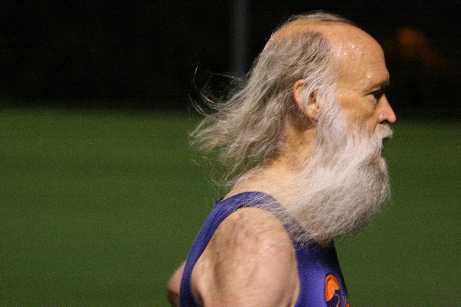 | Bottom line: two mile race 13:53, pushing hard; one mile (half an hour later) 6:42. No timing information for my 400m leg of the relay (another 30 minutes later) with Christina Caravoulias, Jeanne Larrison, and Don Libes, but I suspect it was also in the 6:45 ballpark. Lesson learned: what one eats before a fast run sometimes matters! |
(photos by Ken Trombatore)
- Saturday, August 28, 2010 at 17:31:49 (EDT)
Sneaky Management Trick #106: ask the employee to name the date when a task will be completed. If s/he mentions events which might arise and cause a delay, say "OK, taking all of that into account, when will you be finished?" Then wait for the answer with pen poised over calendar to write it down. When people pick their own due date for a project it makes them feel far more committed to completing the job on time. And when, as we all do, they discover that they've been too optimistic, they learn to estimate better.
Worker Counter-Trick: refuse to name a date—but agree on a deadline for choosing one, e.g., "I can't estimate right now, but I'll be able to next Wednesday, Boss!"
(cf. BetterFasterCheaper (1999-05-29), ...)
- Friday, August 27, 2010 at 04:48:59 (EDT)
| Torque a nerve till tingles linger Tie taut tendons into knots Twist cartilage to mangled tangles Tear ligaments until they pop |
"Good job on that hill!" a dog-walker tells me. It's another warm, humid morning as I trot down Georgetown Pike past Langley High School and, after ~29.5 minutes, turn back at Balls Hill Rd. The return journey is ~29 min. Water sprinklers wastefully wet the bikepath.
(cf 2009-06-24 - Balls Hill Rd, ...)
- Thursday, August 26, 2010 at 04:51:46 (EDT)
Comrade Caryn rolls down her window and wolf-whistles at me as she drives past. A jackhammer busts up the sidewalk, preparatory to replacing old concrete slabs. At 0730 I trot out to circle the office complex this warm and humid summer morning. The ~1.5 mile loops are at approximate paces 9.7 + 8.8 + 7.7 min/mi.
- Thursday, August 26, 2010 at 04:46:01 (EDT)
Want to make progress on a major long-term writing project? There's excellent inspirational advice in Erin E. Templeton's brief essay "The Rule of 200". An excerpt:
The Rule of 200 works like this: my document word count must increase by 200 before I am done for the day, no exceptions. 200 words is a modest goal. It isn't even an entire page of double-spaced 12pt font. It's a grocery list, an email, a series of text messages; it's a lot shorter than most of my ProfHacker posts (this one included). Sometimes it takes me 15 minutes to write 200 words. Sometimes it takes all day long. But no matter what, before my head hits the pillow for the night, the word count is +200.
I write 200 words a day, every single day, until I have an entire draft. "Every single day" includes weekends, long days on campus, holidays, even my own birthday. I first encountered the "no exceptions" idea in Joan Bolker's helpful Writing Your Dissertation in 15 Minutes a Day. Bolker's reasoning is that if you spend just 15 minutes a day, every day, on your dissertation, you will keep momentum and maintain progress. Similarly, the Rule of 200 helps me to feel like I'm moving forward through the drafting process, which for me is the most painful part of writing. I tried Bolker's 15-minute process too, but while it was helpful, focusing on the number of words instead of the clock gave me a more concrete goal and visible results.
200 words can be anything as long as it contributes to the complete draft. Sometimes it is a big idea. Sometimes it is a block quote. Sometimes it is an explication of the previous day's block quote. Sometimes it is working out an idea that I know I want to include but I am not sure where it will fit.
200 words + 200 words = 400 words. 400 words + 200 words = 600 words... As you marvel at my math skills, let me point out that all of these words add up. The bottom line is the count, and for me this is very important because I like to tinker with my words. Without this system, I have a tendency to fixate on the wording of a sentence or a phrase as a form of procrastination rather than on getting the ideas out. I do not mean to suggest that there isn't a time and place for tinkering or polishing one's prose, but that time and place is not the initial draft. A little bit at a time is, for many of us, less stressful and more productive than the other method of writing that I was fond of in graduate school: the binge and purge.
If the words are flowing more easily, by all means don't stop at 200, but there is no "rollover plan." If you have more time to write, then keep writing, but you still owe another 200 tomorrow even if you up the count by 1000 today.
Of course, 200 isn't a magic prescription; just about any positive number will do. A professional may do more, and quality counts for more than quantity—as long as quantity is nonzero, that is!
(thanks to the Brown Studies blog for showcasing Templeton's essay; cf. SelfReliance (1999-06-16), SiteSuggestions (2004-07-08), John McPhee (2008-03-09), Perseverance (2009-02-19), ...)
- Wednesday, August 25, 2010 at 04:40:30 (EDT)
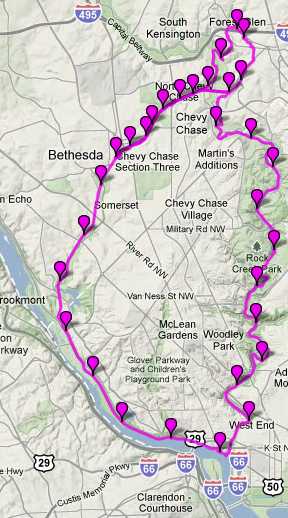 | "Vanity of vanity, all is vanity." Ecclesiastes 1:2. On the way home it looks as though the GPS will read 29+ if I go the direct route, so I divert from the Capital Crescent Trail at Jones Mill Rd and go via Susanna Ln to Rock Creek Trail. The extra half mile gets the display to read 30.2 and makes the ego happier. And when I run out of water with a few miles to go I tell myself that dehydration will lower the number on the digital scale—which it does, to 149.0 lbs. All is vanity! |
The moon is a thin crescent in the east as I set out before dawn. A rabbit runs ahead of me on the CCT. I wait 20 minutes at the Bethesda parking lot for the group to gather, The GPS keeps running all the time, and at latrine/water stops, so perhaps the pace while "moving" is ~1 min/mi faster. My right knee feels "weak" but not "achy" after a few hours, no matter what I do nowadays. This reminds ever-cheerful Rebecca Rosenberg of the "Beverly Hillbillies" sitcom episode with Granny's common cold cure, a foul concoction of possum guts and what-not. Take it and you cold goes away in 7 days, instead of lingering for a week! Rebecca and I sing the "Beverly Hillbillies" theme song in chorus as we pass the National Zoo.
Gayatri Datta and I stick together for the whole 21 mile loop. She pulls me along especially during the middle. At the end, I walk much of the final mile home, Possibly it's due to sodium and potassium deficit, since I foolishly only bring one electrolyte capsule with me and one energy gel. The Clif Builder's Bar I eat along the way perhaps helps some, but perhaps causes some minor intestinal distress. Good lessons to learn for future long treks!
(cf. 2005-10-23 - CCT-RC Loop, 2006-10-07 - Caren's Loop, 2007-10-20 - Mary's Loop, 2009-01-10 - CM's Loop, ...)
- Tuesday, August 24, 2010 at 04:36:59 (EDT)
A bumper sticker for managers:
| Mission Happens |
... meaning sometimes you've just gotta buckle down and do the dirty job that you're getting paid to do!
- Monday, August 23, 2010 at 04:43:13 (EDT)
A yellow-and-black caterpillar with an orange head humps its way along a twig; unfortunately, the twig is lying on the ground, so I wonder what the bug will do when it gets to the end and finds no leaves. By the time I pass on my next lap, it's gone. A cool morning tempts me out onto the woodsy loop at work again at 7:30am; no one else is there. On the first circuit I try breathing every four paces (inhale 4 steps, exhale 4 steps), then pick up the pace and for the next 1.1+ mile do a full breath every three paces, then every two, and on the fourth go-around it's a breath every pace. My mile-marker times accelerate accordingly: 10.3 + 9.4 + 8.3 + 7.2 min.
- Sunday, August 22, 2010 at 04:11:52 (EDT)
A vocabulary word to join crepuscular in the animal behavior scrapbook: cursorial, referring to a creature specifically adapted to run. ("Cursor" comes from the same root.) I saw "cursorial" first in the book Why We Run: a Natural History by Bernd Heinrich. The Wikipedia definition mentions arboreal, which I knew had to do with living in trees, and the neat-looking fossorial, "... adapted to digging and life underground such as the badger ...".
Which of course reminds me of one of my favorite lines in The Wind in the Willows (1983 animated film version), when curmudgeonly Badger declines an invitation to join friends for dinner with, "I've got a prior engagement: I'm dining alone!"
- Saturday, August 21, 2010 at 04:42:02 (EDT)
I'm not planning to run on this humid morning, but enthusiastic colleague Stephanie drags me out for two laps on the paved jogging "trail" near work. The first marked mile is at 10.3 pace and the second, which I insist on pushing, goes by in 8.8 minutes.
- Friday, August 20, 2010 at 04:43:44 (EDT)
Caren Jew meets me at the Lake Needwood parking lot and downstream we head along RCT, taking walk breaks as needed and enjoying the early Sunday morning. No signs forbid us, so although it's still unfinished we cautiously venture onto the pedestrian bridge over Veirs Mill Rd and view traffic passing below. There are no safety railings, equipment is strewn about, and the concrete is covered in plastic sheeting.
Caren has The Eye and on the way back points out a barred owl and a chipmunk. To add some hill work we cross the scary metal mesh bridge and climb the side trail to Marcia Lane and Linthicum Street as used in the long-ago 2005-11-13 - Rock Creek Park Marathon and Relay (see map). I amuse Caren by reminiscing about the volunteer at the top who gave me a powdered donut during that race. We push between mileposts 13 and 14 to make the final mile in 11:34, and follow it up with a cooldown loop around the parking area road.
- Friday, August 20, 2010 at 04:39:53 (EDT)
Recently in the news: a purported proof that P ≠ NP. It's an important issue in computational complexity, one of the famous Millennium Problems worth a cool million to the solver.
Recently during an online chat: comrade George tells me that he's been convinced P≠NP ever since he learned about the Boolean satisfiability problem. My reply apparently made him laugh. I wrote:
Mark Zimmermann: I can't get no (Boolean) satisfaction
Mark Zimmermann: though I've tried ...
- Thursday, August 19, 2010 at 04:38:33 (EDT)
| The less power somebody has, the more they abuse it! |
(cf. DelicatePower (1999-12-12), ...)
- Wednesday, August 18, 2010 at 04:43:39 (EDT)
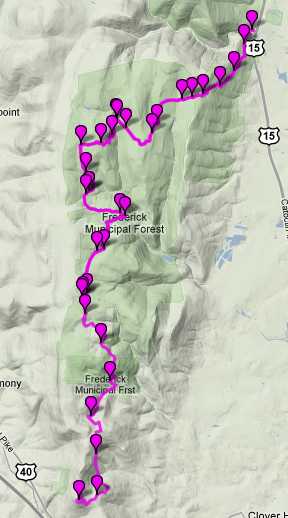 | "It's not a race, it's a training run!" I tell Kate during the days before today's trot over the hills, across the rocks, and through the woods of northern Maryland. Officially we're in the Catoctin 50k race. But we both agree not to push the pace and not to worry if we don't make the cutoffs. Kate's hamstrings seem sore and I'm stumbling, so we enjoy the scenery and strive (successfully) to avoid injury. When Aid Station captain Ed Schultze pulls our numbers at mile ~23+ (Delauter Rd) for being behind schedule we carry on for another three miles to Hamburg Rd. That aid station is shutting down, however, and there aren't enough fluids left to resupply both us and the sweepers who arrive behind us. So Kate and I decide to hitch a ride back to the start/finish with the kind volunteers there. Hasty racers somethings inadvertently drop things. As we trek along Kate and I pick up litter to keep the wilderness wild. During the first quarter mile I snag an unopened Clif Shot energy gel. On the way back, there's a more exotic find: a new, still-wrapped sanitary napkin. And of course we remove the usual bits of trash, bottle-caps, paper cups, and candy-wrappers. Toward the end of the run bending over to pick things up becomes a challenge.
|
| During the steep descent to the midpoint at the Manor Area my phone rings. It's Caren Jew, checking up on us! She and her lovely daughters Ashley and Jenna are waiting to cheer us along. Thanks, Caren! As we approach the turnaround sweepers catch up with us and dog our path. On the way back Kate and I accelerate, opening up a gap. At Gambrill Park Rd the aid station volunteers are sipping beer and kindly offer us some. We decline: stability is essential on this rocky terrain. Only after we're a mile farther along do I realize that we should have told them to give the sweepers drinks, to slow their pursuit.
| 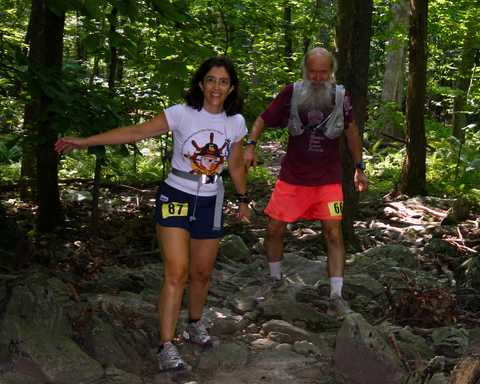 |
The table below shows timing information from Catoctin 50k runs in 2008, 2009, and this year. Note that the "official distance" for 2008-2009 is an underestimate. In 2010 the course is an additional half mile or so longer in each direction due to rerouting of the trail between Delauter Rd and Fishing Creek Rd. My GPS indicates 26.5 miles at the final Hamburg Rd aid station, for instance, instead of the purported 25 miles.
| 2010 time | 2009 time | 2008 time | cutoff | official dist. | location | |
|---|---|---|---|---|---|---|
| 1:53 | 1:37 | 1:42 | 1:45 | 6 | Hamburg Rd | |
| 2:47 | 2:17 | 2:28 | 2:35 | 9 | Delauter Rd | |
| 3:29 | 2:48 | 3:05 | - | - | Fishing Creek Rd | |
| - | 3:16 | 3:37 | - | - | Gambrill Park Rd | |
| 4:36 | 3:44 | 4:10 | 4:15 | 15.5 | Manor Area | |
| - | 4:26 | 5:04 | - | - | Gambrill Park Rd | |
| 5:52 | 4:56 | 5:43 | - | - | Fishing Creek Rd | |
| 6:35 | 5:27 | 6:24 | 6:20 | 22 | Delauter Rd | |
| 7:32 | 6:13 | 7:27 | 7:15 | 25 | Hamburg Rd | |
| - | 7:53 | 9:45 | 9:15 | 31 | Tea Room |
- Tuesday, August 17, 2010 at 04:43:48 (EDT)
Who Moved My Cheese? is a win-win-win little book:
Motivational speaker and business consultant Spencer Johnson tells an extended parable involving cheese in a maze and the reactions of different types of individuals when it's not where they expect it to be. The story is plodding, there's no characterization to speak of, the use of language is pedestrian, and in case you don't get the point there's a preface and a postscript to hammer it home.
Change happens and it's smart to anticipate it, adapt to it, and be happy about it. Instead of paying $20 and spending an hour on Who Moved My Cheese? to hear that, it's more fun and arguably more productive to read a good children's book like one of Arnold Lobel's Frog and Toad collections, or Margaret Wise Brown's Goodnight Moon, or a few of Beatrix Potter's Peter Rabbit stories. Or in a more philosophical vein, glance over a chapter about mindfulness and stress reduction by Jon Kabat-Zinn, e.g. in his books Wherever You Go, There You Are or Coming to Our Senses. His classic summary of the goal: "Nothing is to be clung to as I, me, or mine." Or even shorter the bumper-sticker mantra: "No attachments!"
- Monday, August 16, 2010 at 08:18:40 (EDT)
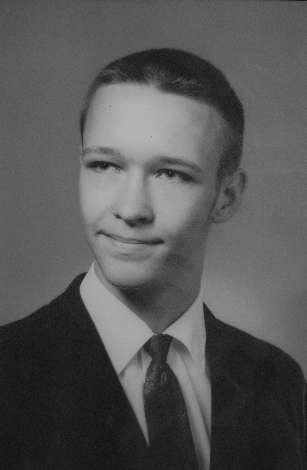 | Mark Zimmermann in an official photograph, ca. 1970, John H. Reagan High School, Austin, Texas. My how times flies! |
- Sunday, August 15, 2010 at 08:58:30 (EDT)
I'm ready to taper for the Catoctin 50k next Saturday, but colleague Stephanie wants to run so I meet her at 7:30am and we do a couple of laps around the parking lot perimeter, first in ~16 minutes and then accelerating to ~14.5 in the humid morning. Another young lady paces us and finishes slightly in front. Workmen slap paint on the bright yellow gates.
- Saturday, August 14, 2010 at 07:34:00 (EDT)
If understanding uncertainty is important to good critical thinking, then so is Bayesian statistics. New evidence comes in: how does that change one's estimate of the probability that something is true? Bayes's theorem provides an answer. For a highly readable introduction to the subject, Donald A. Berry's Statistics: A Bayesian Perspective is an excellent starting point. It's a fast-paced undergraduate textbook that requires no calculus or other mathematical background. The author (formerly a professor at Duke University, now a department head at the University of Texas Medical Center) is very much first-person in his presentation. He focuses on practical examples and case studies that range widely, and entertainingly, over areas including violence on TV, malaria and sickle-cell anemia, baseball injuries, burrowing owl nests, causes of cancer, tornado forecasting, and a host of other topics.
Berry begins by introducing general concepts of probability and statistics. Along the way he presents diverse examples of good data visualization and guidelines for displaying quantitative information. The author's humorous yet critical asides are a frequent delight. For example, in Chapter 2 ("Displaying and Summarizing Data") he notes:
... If you arrange a set of groups so the bars go from low to high or high to low, the eye picks this up and associates a trend. There are several ways of displaying data and the displayer can choose the one that makes a point best. The problem is one of "multiplicities" (to be discussed in Section 3.4). There may be no way to tell a story—any story!—without deceiving. As a reader, you have to be aware of the options available to authors and make suitable adjustments. When you are the author, be aware of the power of charts and graphs and of the inevitability of deception.
And in Chapter 12, discussing the independence of samples from two populations, he observes:
... This assumption may not be perfectly apt in every problem we consider, but it holds at least approximately in all of them. Moreover, as I have indicated before, if you do not make assumptions, you will get nowhere. Make assumptions, and worry about whether they are appropriate.
Berry discusses how to gather data or design experiments to test hypotheses, and demonstrates a healthy skepticism about much published research. In Problem 12.15 dealing with "How does background music affects worker productivity?", e.g., he notes parenthetically:
I worry that the design of this study does not produce random samples from the appropriate populations and so the calculations you make are therefore themselves inappropriate. The workers in the study were not randomized to the two units. Work units are cultures in and of themselves, with work speed and "attitude" rubbing off from one worker to another. There is an aspect of this type of design for which the experimental unit is the work unit and not the worker. If that were true in the extreme, this study provides a sample of size 1 from each population of work units, ... . Conclusions are weak when the sample sizes equal 1, unless the prior information is convincing.
And in Problem 12.27, "concerning the effect on housefly lifetime of exposure to 100% oxygen":
My reservations about the design of this experiment are similar to those in the previous exercise. I do not know how many cases were used for each group, but I think there was only one. Cage variability should be assessed. Doing so requires multiple cages. Also, the effect of oxygen may depend on the number of flies in the cage, which therefore should itself be varied. Moreover, the results are sufficiently nonintuitive that there may have been a handling difference of the Temp. O2 and control cages that would cause a reversal of the expected results. That the researchers can explain their paradoxical results may be reassuring, but it is far from convincing; the human mind can explain any observation—even those that are wrong!
Berry doesn't overlook the value of negative evidence either. In Chapter 13, "Outliers", after discussing how important samples far from the norm can be, he points out:
... This interval is inappropriately narrow because the population is not normal. So you need to be concerned about outliers even if you do not see them! Like a species of mosquito in which the males buzz but do not bite and the females do not buzz but bite—you have to worry as much when you hear nothing!
As with the dog that did nothing in the night-time, that's a widely applicable concept.
(cf. Statistics: A Bayesian Perspective, Donald A. Berry, Wadsworth Publishing Co., 1996)
- Friday, August 13, 2010 at 04:35:43 (EDT)
Passing thunderstorms on Sunday have left tree limbs and smaller branches strewn across and around the pathway. My legs feel tired, but a cool front came through recently and I can't resist the chance to get out and run in the morning, even though it's a bit humid. Two ladies are jogging ahead of me along the trail near work. I try to go slowly but soon pass them, and later in my first lap am passed by a fast-moving young man. The marked miles go by from holding-back to pushing-hard pace: 10:20 + 9:42 + 8:22 + 7:30.
- Thursday, August 12, 2010 at 04:37:56 (EDT)
After intermittent twinging for some months, my right knee felt fine during and after the 53.7 mile trek that Kate Abbott and I took together (2010-05-15 - Half Massanutten Mountain Trails). But a few days later, after a short walk to the Metro and a climb up the long Rosslyn escalator stairs, the old joint really began to ache. What to do? Of course, I followed the classic advice that one addicted runner gives another: Up your mileage! Foolish, I know, but it seemed to work.
So yesterday I had to laugh when, in Chapter 7 of Why We Run: A Natural History by Bernd Heinrich, I read about the author's experience in the late 1970s:
Soon after I started training, I got a knee pain. I went to an orthopedic surgeon, who said, "You have (some sort of) cartilage degeneration. If you don't stop running, I'm going to have to take your kneecap off and throw it in the garbage can." His exact words. They rang in my ears a long time. I figured, instead, that I had a loose piece of cartilage, which I could get rid of by grinding it down by running, So I increased my mileage.
(cf. 2010-03-20 - CCT Wimp-Out, ...)
- Wednesday, August 11, 2010 at 04:43:53 (EDT)
| After a mile my crimson shirt is sweat-soaked and comes off, to wrap around an arm. It's my first run in new scarlet Brooks "performance" shoes; they feel good on the old feeties. Approaching the finish line I put the shirt back on. "You don't know how lucky you are!" I tell Karsten Brown as he takes my picture there. (photo by Ken Trombatore) | 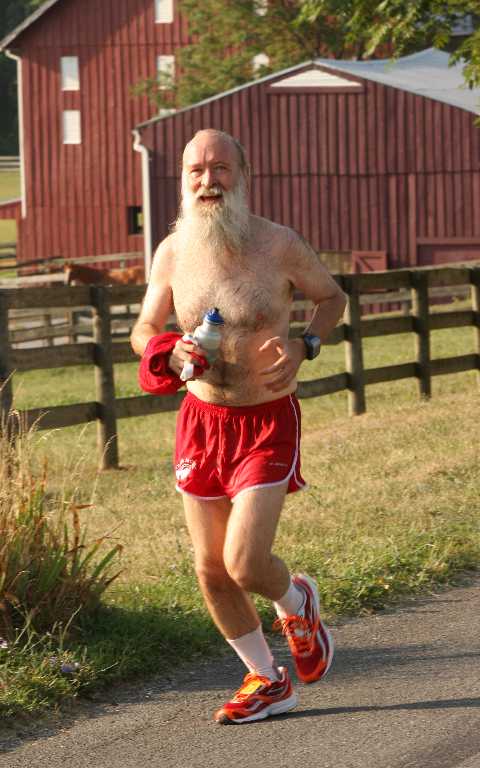 |
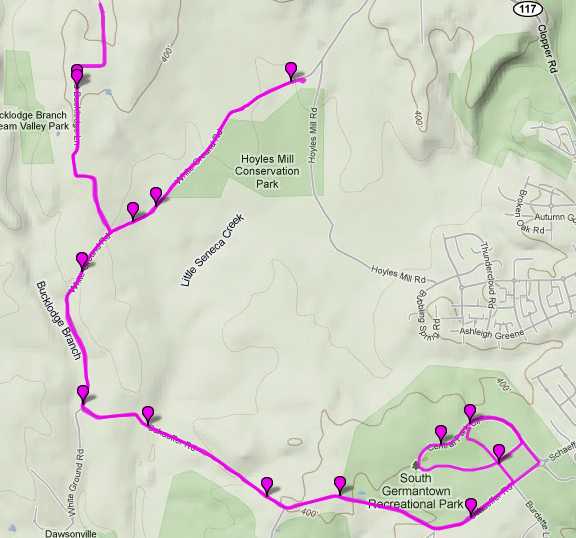 | Hot, humid, and hilly—that just about summarizes the 2010 Riley's Rumble half marathon. I'm two minutes slower than last year (2009-07-26 - Riley's Rumble Half Marathon) when I did 1:55:33 on an uncertified course estimated to be ~0.4 miles too long. Before the start I take two S! e-caps and along the way I drink salty Zelectrolyte lemonade-tea. An ice-pop from Don Libes at about mile 10 is refreshing, but nevertheless the final uphill miles are slow, with rough GPS-estimated splits of 7:40 + 8:07 + 8:17 + 8:14 + 8:53 + 9:02 + 8:49 + 9:41 + 9:38 + 9:02 + 8:37 + 10:39 + 8:54 + final fragment at 7:56 min/mi pace. (map via Google + GPSvisualizer) |
| Hills dominate, as this elevation profile from GPSvisualizer suggests. Before the start I give Gayatri Datta and Barry Smith electrolyte capsules. Gayatri later tells me that she gave one of hers to a runner in distress during the race. Ken Swab gets overheated and breaks out in goosebumps. Temperatures during the race rise from the low 80s, with dew point in the upper 60s. Before the start the race officials declare today's event a "Fun Run" to discourage competitors from trying too hard and getting into medical trouble. There are no official results. | 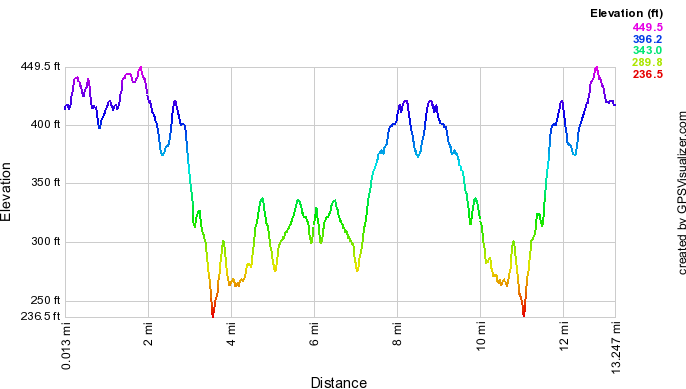 |
(cf. RileysRumble (2003-07-27), 2004-07-25 - Riley's Rumble Half Marathon, 2006-07-23 - Riley's Rumble 2006, RileysRumble2007 (2007-07-30), 2008-07-27 - Riley's Rumble, 2009-07-26 - Riley's Rumble Half Marathon, ...)
- Tuesday, August 10, 2010 at 04:57:36 (EDT)
Last month my Father, Werner Zimmermann, drove my son Robin and me around the east-central Texas area he grew up in. A striking feature of his commentary: all the house moving that went on over the years. The little two-room school that he attended began on one patch of land and years later was shifted down the road to sit near the church. Other homes that family and friends lived in were likewise transported, sometimes for miles. Farms were sold but not the houses on them, and vice versa. It wasn't a historical-preservation issue either. Apparently structures were better-built then and were worth more than they are nowadays, in our era of knock-down and rebuild. Fascinating!
(cf. Howl's Moving Castle (2009-03-22), Dorothy Zimmermann, R.I.P. (2009-08-21), Double Shot Liquor and Guns (2010-07-20), ...)
- Monday, August 09, 2010 at 04:51:54 (EDT)
| A Dahn yoga ad caught my eye several years ago in a local newspaper, and I've been carrying around a ragged-torn copy ever since. Somehow the lotus position—calm, open, balanced, meditative, almost-but-not-quite symmetric—captivates my mind. (Or maybe it's just the exaggerated feminine shape of the artwork?!) Likewise mudras, symbolic hand-gestures, enchant me. A Parvati as Boga Shakti statue that my wife brought home some time ago, for instance, has fingers held in a mudra, representing I know not what. Fascinating! (Or maybe it's justy the exaggerated feminine shape of the artwork?!) Do certain postures have an ability to modify mental states, intrinsically or via association? Can moving or posing a certain way produce profound health benefits, physical or spiritual? Or is this all mere mysticism, the common fantasy of something-for-nothing? Sit this way, hold your hands that way, and take a shortcut to wisdom, peace, happiness? One wonders ... |  |
- Sunday, August 08, 2010 at 11:41:31 (EDT)
As the sun rises I spy a big baggy pair of reversible black/white nylon shorts by the sidewalk on the way to the LBJ High School Track. When they're still lying there in the grass during my return trip I snag them; they're missing a waist cord but may be reparable. This morning I mostly have the track to myself, though at first there's a young guy jogging, in the middle a woman walks laps as her daughter kicks a soccer ball, and at the end one of the friendly lady walkers I saw on 2010-07-15 - LBJ Ladder arrives and commences her stroll. We exchange "Good Morning!" greetings.
"Yasso 800s" are today's prescription: ten 800 meter repeats. It's warm and humid even at 7am: I doff my singlet and fling sweat droplets when I shake my head during the 200m recovery interval walks. After the 1.4 mile jog to the school the splits are 3:47 + 3:53 + 3:47 + 3:48 + 3:53 + 3:56 + 3:55 + 3:56 + 3:54 + 3:41—whew!—that last one requiring extensive walking to recover.
(cf. 2006-07-07 - Texas Homecoming Speedwork, 2006-07-12 - Slower Texas Speedwork, 2009-07-16 - Texas Speedwork, ...)
- Saturday, August 07, 2010 at 04:34:32 (EDT)
A slip-of-the-tongue by a lecturer a few days ago: "transpiracy" (she pronounced it "trans-PEER-a-see"). What might it mean? A transparent conspiracy, perhaps one in which the plotters are incompetently obvious? And how about the converse, "consparancy"? Hmmm, that sounds like complete sharing of information within a secret society.
- Friday, August 06, 2010 at 04:38:14 (EDT)
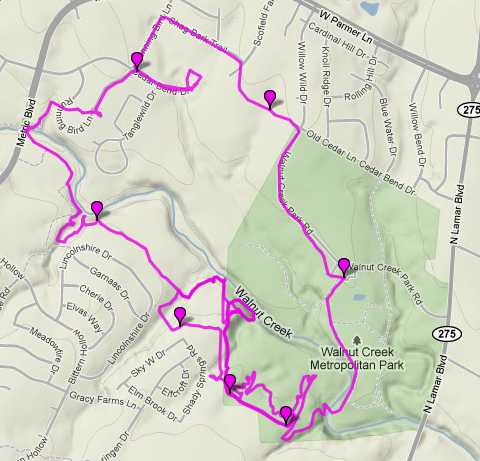 | The mountain bike courses have apt names: "Tangle of Trails" ... "Hill of Despair" ... "Severe Consequences" ... etc. It's the morning after my afternoon adventure (2010-07-19 - Walnut Creek Metropolitan Park) in northwest Austin. I'm back to get my revenge—or rather, to get befuddled in the labyrinth of mountain bike trails in Walnut Creek Metropolitan Park. I park near the swimming pool and in spite of consulting my GPS keep looping around and finding myself repeating segments of the course. A pack of early-morning runners greets me, as do a pair of cyclists. After dead-ending on cliffs above the stream and revisiting the high-tension power line right-of-way, I unwittingly emerge on the northwest side of the park. Then it's a ramble along neighborhood sidewalks, punctuated by retreats from dead-end streets, abrupt stops at barbed-wire fences, and turnabouts at thickets of bramble bushes. Finally I follow the park boundary fence next to an elementary school and discover a proper entrance. The road leads me back to my starting point. |
- Thursday, August 05, 2010 at 04:48:37 (EDT)
Finding the Quiet by Paul Wilson is a thoughtful guide to mindfulness meditation. In the second chapter, the section called "The art of letting go" offers the advice:
... be prepared to allow things to happen at their own pace. Without applying effort. Without trying to analyze in any way. And without expecting any particular outcome.
Wilson expands upon these themes:
Without effort ...
... So get used to the idea of doing nothing, applying no effort, and just allowing things to happen and unfold in their own good time. However long it takes is exactly how long it's meant to take.
Without analysis ...
... As human beings we are desperate to rationalize and find the meaning in everything. But there is no meaning to be found in the act of meditation. Its purpose is just to still the mind so you can observe what is real. ...
Without expectation ...
... you are not using your practice to attain something, because the practice itself is the attainment. Impatience vanishes. You have all the time in the world.
(cf. Jon Kabat-Zinn commentary This Is It (2008-11-14), No Method (2010-01-21), Dimensionless and Therefore Infinite (2010-02-03), Being with Your Breath (2010-02-20), ...)
- Wednesday, August 04, 2010 at 05:16:24 (EDT)
"No, the other right—my bad!" one mountain biker says to another.
"Do you mean the other left?" I ask.
"Yes, that's the one!" he replies.
I'm in the Walnut Creen Metropolitan Park on the north side of Austin Texas. Today in the local newspaper Pamela LeBlanc has an enthusiastic article about trail running [1] that lists courses in the area. This park is #2. Unfortunately I try running it in mid-afternoon, with temperatures in the upper 90s and high humidity. Before I start my little GPS wrist unit locks up. (Only later do I learn the Garmin 205 reboot trick: holding down the "Mode" and "Reset" buttons simultaneously.)
I soon get lost on the snaky maze of mountain bike trails, just as has happened at Fountainhead repeatedly, at Schaeffer Farms, and at Cunningham Falls. In 20 minutes I'm at the top of a cliff, the "trail" I've followed terminates in brambles, a "No Trespassing" sign warns me not to invade adjacent church property, and poison ivy sends me backtracking. I random-walk until I find a path back to the parking lot. It's all good! I'll be back tomorrow ...
- Tuesday, August 03, 2010 at 05:05:19 (EDT)
Another obscure word for the linguo-scrapbook: banausic, which is used at one point in the book Problems of Knowledge. It means mechanical, mundane, routine—and though it looks a bit like "banal" apparently it's unrelated to that; the root is ancient Greek from a word for manual laborers or artisans. According to the Wikipedia article "banausic" first appears in English in the 1800s. That same article comments "It has been conjectured that the Elizabethan use of "mechanical" (as in e.g. Shakespeare's Midsummer Night's Dream) is a translation of banausos."
- Monday, August 02, 2010 at 05:00:02 (EDT)
Two black dogs dash out to bark at me as I pass their home in the pre-dawn gloom. Son Robin and I are visiting my Father at his farmhouse near LaGrange and at 4:50am I set off to find the family church along the untraveled back roads. Unlike my last attempt (2009-08-09 - Dorothy Zimmermann) this time from Peeler Rd I turn right, not left, on Knape. It leads me to Onheiser-Kaase Rd (my father's mother's family was Onheiser and had land near here) which takes me to Niese Rd to the Swiss Alp United Evangelical Lutheran Church at roughly 4.5 miles. Lightning flickers silently in the distance.
The dogs sniff my hand, then follow me for the half mile to the church where I circle around the flags and head back. They're clearly enjoying themselves, sniffing at trash and taking excursions on the shoulders of the roads to chase imagined critters. At their home I try to tell them good-bye, but they're having none of that: they continue to follow me, trotting comfortably along behind. "Go home!" I command. "You idiots! You'll get lost!" They ignore me. Back at FM 609 I lead them up Zimmermann Lane to avoid a passing car, then down my Father's driveway and offer them water. They seem to feel fine and frisky. Dad and I wrestle them into the back seat of his car where they enjoy a ride back to where they belong. One of them has a collar tag that says his name is "Buddy". We let them out of the car and speed away before they can follow us and get lost again.
- Sunday, August 01, 2010 at 04:38:13 (EDT)
 | Another photo from my Mother's collection: me in the second grade. |
- Saturday, July 31, 2010 at 04:16:32 (EDT)
A crepe myrtle in bloom rains down magenta blossoms on me as I brush past. From my Mother's home at sunrise I trot to the LBJ High School track and do ten 200 meter interval repeats at 43-45 seconds each, with ~2 minutes of walking the 200m recovery between each. Two young men are also doing laps there. On the way back three families have already filled their front lawns with Saturday morning yard sale merchandise.
- Friday, July 30, 2010 at 04:40:18 (EDT)
Problems of Knowledge: a critical introduction to epistemology by Michael Williams is an interesting, well-written philosophy book. Its relevance to ordinary life? Mainly to raise awareness of issues, some quite subtle, associated with what we believe and why, how we can be wrong, and how to fix our inevitable mistakes. Epistemology is like the infrastructure of knowledge: the plumbing, electrical wiring, air handlers, etc. that make the rest of the job possible. We don't want to worry about infrastructure most of the time. But we do want it to be reliable and we definitely need to know when it's in danger of breaking down due to stress beyond what it's built to handle. Likewise knowledge.
In his Introduction Williams begins by defining epistemology, "the theory of knowledge". He lists five key problems that will be the focus of the book:
The answers to these occupy the next 250 pages, and are not always clear. (If it were possible to summarize briefly, then the book wouldn't be necessary!) Among the major conclusions in Problems of Knowledge:
Problems is far from easy reading. It's not a textbook, but as the author says in the preface, "I think that philosophical ideas are important, so that they ought to circulate outside narrowly professional circles; and I think that they can be made to do so, if not in full rigorous detail, then at least not in hopelessly garbled form." Problems attempts to bridge that gap.
(cf. EpistemologicalEnginerooms (2000-08-10), Red Patch Now (2008-06-21), Water Conservation and Epistemology (2010-07-03), ...)
- Thursday, July 29, 2010 at 04:42:56 (EDT)
Navigation is shoddy as I drive my Mother's car down to the reservoir formerly known as "Town Lake", renamed a few years ago for Lady Bird Johnson, to run the loop trail. From Pleasant Valley Rd I turn onto Cesar Chavez and then take Comal Av down to the waterfront, park, and set off shortly after 7am. This time I go counter-clockwise, the opposite direction circuits in past years, around the lake. Dozens of runners meet me, as do walkers with and without dogs. Before two miles the shirt is starting to chafe my chest so I take it off and wrap it around one hand. GPS says 10:11 min/mi for 10.1 mi, with splits 10:08 + 10:04 + 10:03 + 10:17 + 10:06 + 10:36 + 10:30 + 10:14 + 10:13 + 9:43 + 0:54 for final 0.10 mile.
(cf. 2006-07-08 - Town Lake Loop, 2009-07-18 - Austin Town Lake Loop, ...)
- Wednesday, July 28, 2010 at 04:41:30 (EDT)
During a recent training trek (2010-07-05 - Rock Creek Trail) Rebecca Rosenberg mentioned a film "... about a man training to run a marathon to get his girlfriend back ...". Neither of us could remember the title, but Paulette knew: Run, Fat Boy, Run in its US version, aka Run, Fatboy, Run in the original UK release. I found a used copy of the DVD via the Miracle of the Interwebs and watched it Saturday evening.
Make no mistake: Fatboy is not about distance running. It's a romantic comedy that has, as a plot element, a fictional "Nike River Run". Maybe some of the people involved heard tell of marathon training. Maybe they saw part of a marathon on television. There's no evidence that any of them ever ran one. "Wildly inaccurate" is an understatement for that aspect of this movie. If that bothers you, don't watch it.
"But aside from that, Mrs. Lincoln, how did you like the play?" Simon Pegg, of Shaun of the Dead fame, is the smoking, drinking, underachieving protagonist who leaves his pregnant fianceé, easy-on-the-eyes Thandie Newton, at the altar. Five years later she's being courted by another man, and Pegg decides to win her heart by training (for three weeks!) and running (loosely defined) a marathon. Silliness ensues.
Fatboy in many ways resembles Walk, Don't Run, a 1964 movie ostensibly about race-walking in the Tokyo Olympic games. Both are fun and foolish films, entertaining distractions. (And did I mention easy-on-the-eyes Thandie Newton?)
(cf. http://en.wikipedia.org/wiki/Run_Fatboy_Run and http://www.imdb.com/title/tt0425413/)
- Tuesday, July 27, 2010 at 04:58:38 (EDT)
In Austin Texas visiting my parents, I climb the traditional ladder on the 800m track at LBJ High School: 1+2+3+4+3+2+1 lap sets at ~8 min/mi pace with half a lap (~2 min) recovery walk between each. I start at ~6:30am with a 1.7 mile jog from my Mother's house. Swallows and swifts flit above. At the track the sun rises as a diesel semi warms its engine for half an hour before pulling away with its load of pipes. Three ladies, one African-American and two Latinas, walk laps. "How many more do you have to go?" I ask as I pass one. "Ten—this is the last!" she replies. "My last too!" I pant. Nipple abraison on my sweat-soaked t-shirt awards me a red badge and a painful shower afterwards. Splits from the GPS for the ladder = 1:51 + 3:50 + 5:44 + 7:51 + 5:54 + 3:51 + 1:49.
(cf. past ladders 2006-07-15 - Final Texas Heatwork (9:20 mile) and 2009-08-10 - Beep, Beep, Beep, ... (8:22 mile) ...)
- Monday, July 26, 2010 at 04:46:12 (EDT)
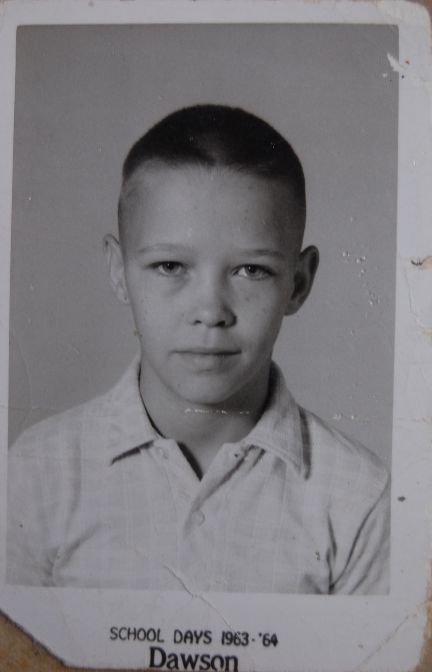 | Me, age 11, at Molly B. Dawson elementary school in the sixth grade, probably early 1964. I remember refusing to smile for the photographer—but not why! |
- Sunday, July 25, 2010 at 04:14:29 (EDT)
Ken Swab lures me into running with him and Cara Marie Manlandro from Ken-Gar at 9am as we chat about this evening's baseball-watching plan: the Frederick Keys are playing the Kinston Indians, and Ken has invited me to accompany him. Paulette asks me to buy some fresh peaches at the Bethesda Farmer's Market—they're in season now—and the run is on the way and a good excuse to stretch my old legs after yesterday's tough Skyline Challenge 50k trail run.
CM is walking toward the parking area as I arrive a few minutes early. The lot is full of cars; several training groups got here before us. We sit on the wooden rail and swing our legs, chattering away for 20 minutes. No sign of Ken—perhaps he has been delayed, or had to park elsewhere? After a jog to CM's car to check her phone a text message from Ken reveals the latter is the case. Back at Ken-Gar we meet Ken and start running at Rock Creek Trail milepost 7.
CM wants to do a few miles with hills after her visit to family in flat Florida, so we head upstream to Garrett Park Rd and take it west, follow the path through Waverly Park, then cross the C&O Railroad tracks at the commuter station. We pass the Black Market trendy restaurant in the core of Garrett Park and soon reach Strathmore Av, which we take west to Rockville Pike at Georgetown Prep boy's school. A loop around the fire hydrant and it's back downhill along Strathmore to RCT, downstream to about mile 5.6, and back to finish with a kick at our starting point. Ken explains baseball lore to CM and me, including the story of "Spuds" Bresnahan who played in a minor league ballpark in Williamsport PA which Ken recently visited.
- Saturday, July 24, 2010 at 12:08:21 (EDT)
Stuck in my mind for a few dozen years: the story "Like Any World of Gree" by C. C. MacApp, a transparent pseudonym for Carroll M. Capps (1917-1971). It was a novelette that appeared in the March 1966 issue of the science fiction magazine Worlds of Tomorrow. The subtitle said, "Except that it was Earth!". The plot, half-remembered now, revolved around a protagonist who struggled against the Gree, a race of overlords that controlled the planet and could read minds. To fight against them, Our Hero (whose name was Steve something-or-other, maybe?) could flip from one mental state (obedient slave) to another (rebel saboteur). Was the yarn as good as it seems in retrospect through the mists of time? Or did it just lodge itself in my cranium for some random now-forgotten reason? Maybe I need to find a copy of that issue and see ...
- Friday, July 23, 2010 at 05:02:45 (EDT)
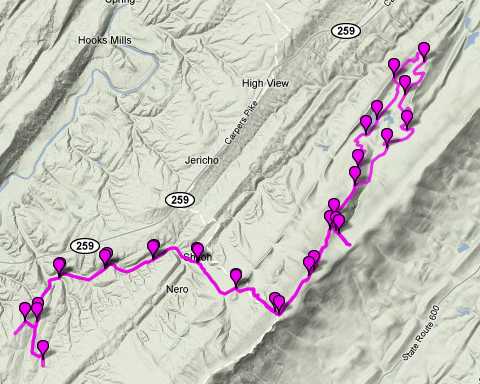 | "Bear!" whispers Kate Abbott, as she stops on the trail in front of me. We're climbing a mountainside at mile 24 of the toughest 50k I've experienced, the 2010 Skyline Challenge. Less than 100 feet ahead an adult black bear is foraging in the brush. I peek over Kate's shoulder and contemplate fleeing. The bear lifts its head, sees us, and hustles away up the hill. Whew! Half a mile later a six foot long black snake sunning itself in the middle of the path is an anticlimax. |
It's the second year of the Skyline Challenge, the first time on a new course. Since the race starts ultra-early on a Saturday morning Kate's husband Victor kindly gives me a lift to their home Friday afternoon. I enjoy a dinner of carry-out Chinese food and friendly conversation with Kate & Victor's lovely sons. At 2am I rise and make coffee. Kate and I set off at 3:15am and arrive at the start/finish—a campground near Gore Virginia—a little after 5am in spite of torrential downpours on I-81. We miss the turn from US-50 onto Gore Rd but hook back and soon locate it. This is a small race, about 150 runners, so sign-in under the canopy proceeds quickly. Rain turns to drizzle. We retreat to Kate's minivan and await the 6am start.
As we stand at the back of the massed runners Kate and I hear an announcement: "Runner #1—the lights are on in your car!" Kate has bib #1 (as usual "Abbott" comes first; I'm last or almost so) and she's pretty sure it's just a map light that I failed to turn off. But as the pack roars away we decide to divert to make sure. (It is.) We're in no hurry today, which turns out to be a Very Good Thing. A quarter mile down the road, solidly in last place, we see a crowd of runners dashing toward us. They all took a wrong turn; the course is only intermittently marked, and the posted map is puzzling. Kate and I step aside for them to sprint by us, then resume our leisurely pace. A few other slow runners join us. I find a shiny new apple on the road, pick it up, and carry it to the next aid station.
The race zig-zags along dirt roads and footpaths that today are mud wallows and small ponds. We climb, descend, climb again. Kate slips and falls, bloodying a knee. Shortly thereafter I lose my footing and coat an arm with mud. It's warm, near 100% humidity, so we're totally sweat-soaked. We're briefly heartened when we see faster runners coming back to meet us from taking wrong turns, which happens frequently. But eventually even the schadenfreude fades. We're walking more than we're running, and the day is young.
At Aid Station #1, mile ~5, I send Kate ahead while I pause to apply grease to already-chafing nether zones. When I rush out of the latrine I overlook the course ribbons and head down a campground road. At the next T-intersection I veer left, see no markings or footprints, reverse course, and still find nothing. After a few minutes of befuddlement I retreat in shame to the aid station where volunteers soon put me back on track. I press hard up increasingly steep hills (see elevation profile below) and eventually—hooray!—see Kate picking her way carefully up a dizzying slope. At the top, where the race joins the blue-blazed Tuscarora Trail, we pause to catch breath. We're exhausted and now in both a figurative and literal fog: a cloud has settled on the ridge line. Through woods and over rocks we go. The next aid station is half a mile off to one side, along a power line right-of-way that traverses a deep valley.
Kate and I have run hundreds of miles together and can say absolutely anything to each other. Kate is braver than me, however, so she breaks the silence first: we're not having much fun. In fact, Bad Words are an appropriate description of our state at this point. We agree to contemplate dropping or cutting the distance short. We could skip the middle segment and make it a 20 mile training run, for instance. I note that there's rumored to be a significant country-road out-and-back for miles 12-22. It may be easier on us than the hills and mud. We confer and agree to reserve judgment until the next aid station.
More runners pass us now, some who went off course, others who started late. After a steep descent over mossy wet-leaf-clad rocks, on which I slip and bruise my hip, we arrive at Aid Station #3 and get confirmation that the next ~10 miles are on-road. Kate and I feel better now and unanimously decide to go onward. Trotting the level and downhill parts of the paved streets we make up some time. We're well ahead of the 12 hour cutoff, and Kate hypothesizes that we might finish in under 9. I remain skeptical.
The faster runners, returning now, are meet us as we proceed. Kate peers at one approaching: "He's carrying a kitten!" she exclaims. Yes, in his hand is a little heap of bedraggled fur. A litter of baby cats was abandoned on the roadside, apparently, and racers are taking them back to the aid station. They're cute; Kate is tempted to adopt one over Victor's certain objection. (Fortunately for her marriage, however, they've all found homes by the time we get back.)
Thus far except for my five-minute solo confusion at AS#1 Kate and I have stayed on the right path. We're in West Virginia now, on Mt Airy Rd. Damp insulators on the high-tension power lines buzz overhead. Mobile homes and small cabins border the street. Kate and I pat ourselves on the back for our navigational prowess now, as we chat about life, physics, family, fellow runners, and the wide range of topics that come to mind in the middle miles of an ultramarathon. Trail talk with a good friend is frank and fun—so much fun, in fact, that for half a mile we don't notice the absence of blue blazes or orange ribbons. Arggghhhhh!
Markers have been infrequent enough that we don't panic; maybe the aid station is just beyond the next hill? No ... perhaps it's around the next corner? Hope dwindles, and finally we turn back. Up hill and down dale we go, cursing our hubris and watching for course signage. Finally, blown halfway around a fencepost and obscured by brush, a streamer appears, and a blue blaze. The route to the mid-course aid station follows a dirt road that branches off.
Our dilemma now: trek the extra mile or more to the official waypoint, or declare ourselves enough over-distance to make it a moral 50k if not an official one? Kate is irked at our mistake and favors cutting our losses, but after a brief debate (and some gentle chiding about her use of salty language) we decide to try the side path. The verdict is swayed by our dwindling total water supply; I have extra and am happy to share, but Kate is running quite low. Up another big hill we slog. At the top we find two cheerful volunteers who are about to close the aid station. We thank them, and though they say it's unnecessary I insist that we run around the woodpile that marks the turnaround. On the way back down to Mt Airy Rd we meet a few other laggard runners and applaud their determination.
| From here on our pace slows significantly. We coo over rescued kittens at the next aid station. We climb the hill, less muddy now in the afternoon sun. My energy level recovers after our adrenaline-charged encounter with the bear. Kate is cheerful and pulls me along the ridge. The fog has lifted and we enjoy views of West Virginia and the George Washington National Forest. The course is asymmetric and the return segment omits the uglier initial muddy roads, branching more directly down to the campground. When we can hear the announcer at the finish line we commence running, and arrive in 9:24, not quite DFL. | 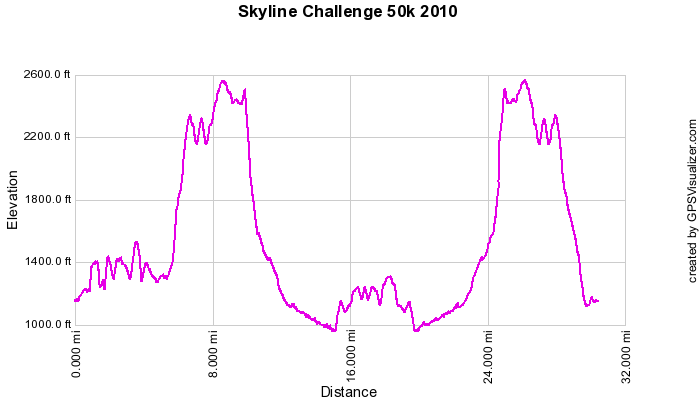 |
(see Skyline Challenge 2010 for Kate Abbott's race report)
- Thursday, July 22, 2010 at 04:55:52 (EDT)
In some classes I've taken, where an individual is performing an exercise in front of an audience of fellow students, to enhance the training experience one of the members of the audience is secretly given a "Blue Card" with instructions on how to cause mischief: ask irrelevant questions, pretend not to pay attention, disagree vehemently with the speaker, etc.
A few months ago at a presentation one of my colleagues was raising lots of objections. "Are you the 'Bad Cop' today?" I asked him.
"No," he said, "but some people say I've got a permanent Blue Card!"
- Wednesday, July 21, 2010 at 13:59:26 (EDT)
For back issues of the ^zhurnal see Volumes v.01 (April-May 1999), v.02 (May-July 1999), v.03 (July-September 1999), v.04 (September-November 1999), v.05 (November 1999 - January 2000), v.06 (January-March 2000), v.07 (March-May 2000), v.08 (May-June 2000), v.09 (June-July 2000), v.10 (August-October 2000), v.11 (October-December 2000), v.12 (December 2000 - February 2001), v.13 (February-April 2001), v.14 (April-June 2001), 0.15 (June-August 2001), 0.16 (August-September 2001), 0.17 (September-November 2001), 0.18 (November-December 2001), 0.19 (December 2001 - February 2002), 0.20 (February-April 2002), 0.21 (April-May 2002), 0.22 (May-July 2002), 0.23 (July-September 2002), 0.24 (September-October 2002), 0.25 (October-November 2002), 0.26 (November 2002 - January 2003), 0.27 (January-February 2003), 0.28 (February-April 2003), 0.29 (April-June 2003), 0.30 (June-July 2003), 0.31 (July-September 2003), 0.32 (September-October 2003), 0.33 (October-November 2003), 0.34 (November 2003 - January 2004), 0.35 (January-February 2004), 0.36 (February-March 2004), 0.37 (March-April 2004), 0.38 (April-June 2004), 0.39 (June-July 2004), 0.40 (July-August 2004), 0.41 (August-September 2004), 0.42 (September-November 2004), 0.43 (November-December 2004), 0.44 (December 2004 - February 2005), 0.45 (February-March 2005), 0.46 (March-May 2005), 0.47 (May-June 2005), 0.48 (June-August 2005), 0.49 (August-September 2005), 0.50 (September-November 2005), 0.51 (November 2005 - January 2006), 0.52 (January-February 2006), 0.53 (February-April 2006), 0.54 (April-June 2006), 0.55 (June-July 2006), 0.56 (July-September 2006), 0.57 (September-November 2006), 0.58 (November-December 2006), 0.59 (December 2006 - February 2007), 0.60 (February-May 2007), 0.61 (April-May 2007), 0.62 (May-July 2007), 0.63 (July-September 2007), 0.64 (September-November 2007), 0.65 (November 2007 - January 2008), 0.66 (January-March 2008), 0.67 (March-April 2008), 0.68 (April-June 2008), 0.69 (July-August 2008), 0.70 (August-September 2008), 0.71 (September-October 2008), 0.72 (October-November 2008), 0.73 (November 2008 - January 2009), 0.74 (January-February 2009), 0.75 (February-April 2009), 0.76 (April-June 2009), 0.77 (June-August 2009), 0.78 (August-September 2009), 0.79 (September-November 2009), 0.80 (November-December 2009), 0.81 (December 2009 - February 2010), 0.82 (February-April 2010), 0.83 (April-May 2010), 0.84 (May-July 2010), 0.85 (July-September 2010), 0.86 (September-October 2010), 0.87 (October-December 2010), 0.88 (December 2010 - February 2011), 0.89 (February-April 2011), 0.90 (April-June 2011), 0.91 (June-August 2011), 0.92 (August-October 2011), ... Current Volume. Send comments and suggestions to z (at) his.com. Thank you! (Copyright © 1999-2011 by Mark Zimmermann.)